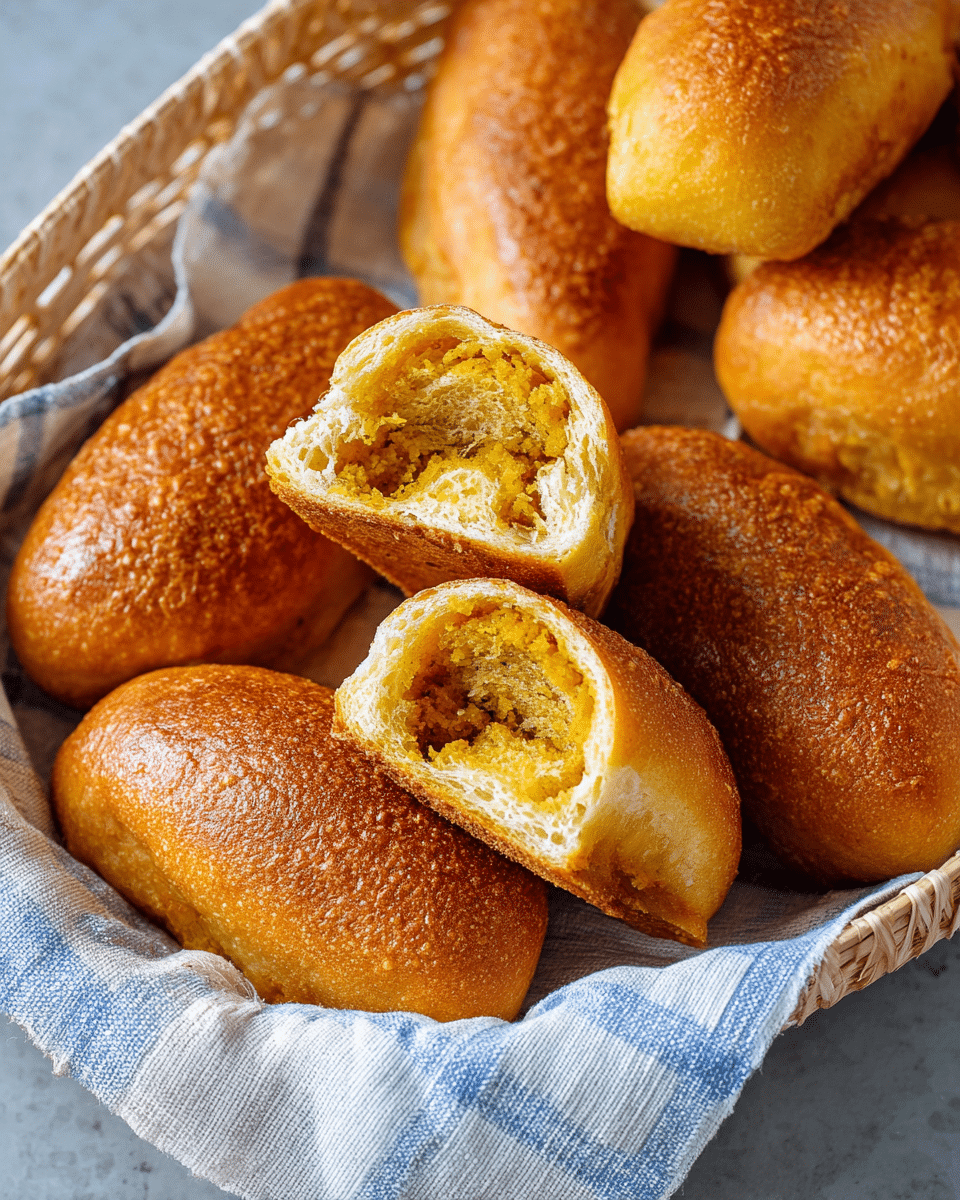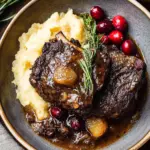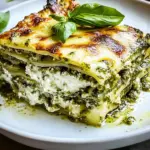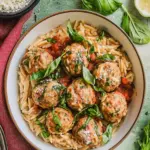These Japanese Curry Breads are delightfully fluffy on the inside, with a golden-brown exterior. The savory curry filling creates a comforting contrast with the pillowy dough, making each bite a satisfying treat. They’re perfect for a cozy snack or light meal, and the homemade touch adds an extra level of love to every bite.
These curry bread rolls are incredibly versatile too. You can use your favorite curry recipe or even customize them with different fillings, like vegetables or meats. Whether you’re new to Japanese cuisine or a seasoned fan, these delicious buns will quickly become a favorite in your baking repertoire.
Full recipe:
Ingredients:
-
1 batch of curry filling (made with your favorite curry)
-
2 ½ cups bread flour
-
1 tablespoon sugar
-
1 teaspoon salt
-
2 teaspoons instant yeast
-
½ cup warm water
-
1 tablespoon olive oil
-
1 egg (for egg wash)
Directions:
-
First, prepare the curry filling and set aside to cool.
-
In a large bowl, combine bread flour, sugar, salt, and yeast.
-
Add warm water and olive oil, mixing until the dough starts coming together.
-
Knead for about 10 minutes until smooth. Place dough in a lightly oiled bowl and let rise for about 1 hour, or until doubled in size.
-
Once the dough has risen, punch it down, and divide it into small portions (about 8-10 pieces).
-
Flatten each portion into a disk and spoon a generous amount of cooled curry filling in the center.
-
Fold the edges over the filling and pinch to seal, shaping each piece into a ball.
-
Place the rolls on a baking sheet lined with parchment paper, cover with a cloth, and let them rise for 30 minutes.
-
Preheat oven to 350°F (175°C). Brush the tops of the dough balls with the egg wash.
-
Bake for 20-25 minutes or until golden brown.
Prep Time: 1 hour | Cooking Time: 25 minutes | Total Time: 1 hour 30 minutes Kcal: 300 kcal | Servings: 8 servings
The Origins of Japanese Curry Bread
Kare Pan has its roots in the early 20th century, and it draws inspiration from both Western and Japanese culinary traditions. Curry itself was introduced to Japan by the British in the late 19th century during the Meiji era. At the time, Japan was undergoing significant modernization and adopting various Western foods and methods of cooking. While curry was initially served with rice, it didn’t take long for Japanese chefs to experiment with the dish and incorporate it into various types of meals.
The creation of Japanese Curry Bread is thought to have been inspired by European breaded and fried items, such as croquettes or other stuffed bread. The first curry bread is believed to have been sold in Tokyo in 1927, where it quickly gained popularity among the working class as a quick and satisfying meal. Over time, this handheld, deep-fried curry-filled bread roll became a staple in bakeries across Japan, making it a beloved street food, perfect for those looking for a delicious and easy snack.
The Making of Japanese Curry Bread
The process of making Japanese Curry Bread is relatively simple, but it requires attention to detail to get the perfect golden crust and flavorful filling. The base of the recipe is Japanese curry, which is made with a combination of vegetables, meat (often pork or beef), and a curry roux that gives the dish its signature rich and savory flavor. This curry is then cooled and spooned into bread dough before the rolls are deep-fried to golden perfection.
Unlike traditional curries that are served with rice, the curry inside these bread rolls is often more concentrated, ensuring that the filling doesn’t leak out during frying. The bread dough is soft and slightly sweet, which balances out the spiciness of the curry, creating a harmonious flavor profile. The deep-frying process gives the bread a crispy exterior, making each bite a satisfying contrast between the crispy outside and the savory curry filling inside.
Why Is Japanese Curry Bread So Popular?
There are several reasons why Japanese Curry Bread has become a popular dish both in Japan and internationally. The first and most obvious reason is its delicious taste. The combination of curry and bread is a crowd-pleaser, offering a perfect balance of spice, sweetness, and comfort. The curry inside the bread is typically rich and flavorful, made from a blend of aromatic spices, vegetables, and meat that create an unforgettable experience with each bite.
Another reason for its popularity is convenience. Japanese Curry Bread is often sold at bakeries, convenience stores, and food stalls, making it easy for people to grab a quick and satisfying meal or snack. Its portable nature makes it an ideal choice for busy people who are on the go but still want to enjoy a delicious and hearty dish.
The deep-fried aspect also adds to its appeal. The crispy outer shell is irresistible to many, offering a satisfying crunch that contrasts beautifully with the soft, flavorful curry filling. It’s the perfect snack for those who enjoy fried foods, and it can be eaten as a meal on its own or paired with other side dishes.
Variations of Japanese Curry Bread
While the classic version of Kare Pan is filled with traditional Japanese curry, there are several variations of the dish that add unique twists to the recipe. Some variations include different types of fillings, toppings, or even alternative cooking methods. Here are a few popular variations of Japanese Curry Bread:
1. Vegetarian Curry Bread: For those who prefer plant-based options, vegetarian curry bread is a popular variation. The filling is made with vegetables such as potatoes, carrots, onions, and peas, cooked in a rich and flavorful curry sauce. This version offers a lighter, yet equally satisfying alternative to the traditional meat-filled curry bread.
2. Seafood Curry Bread: In coastal regions of Japan, seafood curry bread is a common variation. This version of Kare Pan includes seafood like shrimp or fish, combined with a flavorful curry sauce. The seafood adds a delicate and slightly sweet flavor, making it a great option for those who enjoy seafood-based dishes.
3. Chicken Curry Bread: While pork and beef are commonly used in traditional curry bread, chicken is also a popular filling. Chicken curry bread is often made with tender pieces of chicken, cooked in a mild and aromatic curry sauce. This version offers a leaner, lighter alternative to the classic pork or beef-filled versions.
4. Spicy Curry Bread: For those who enjoy a bit of heat, spicy curry bread is a great variation. The curry filling is made with extra chili or hot spices, giving it a fiery kick that pairs wonderfully with the soft bread and crispy crust.
5. Baked Curry Bread: While traditional curry bread is deep-fried, some people prefer a lighter version that is baked instead. Baked curry bread still has the same delicious curry filling but is less greasy than its deep-fried counterpart. It’s a healthier option for those who are watching their calorie intake.
Tips for Making Perfect Japanese Curry Bread
Making perfect Japanese Curry Bread at home requires some practice, but with a few tips, you can master the technique and enjoy this delicious dish whenever you want. Here are a few key tips to ensure your curry bread turns out perfectly every time:
1. Let the curry cool before filling the dough: One of the most important steps in making curry bread is ensuring that the curry filling has cooled down before you put it into the bread dough. If the curry is too hot, it can cause the dough to become soggy or leak out during frying. Cooling the curry also helps it set, making it easier to handle when filling the bread.
2. Use a soft bread dough: The bread dough used for curry bread is slightly sweet and soft, providing a perfect contrast to the spicy curry filling. Be sure to use a bread recipe that yields a light and fluffy dough. If you’re using pre-made dough, ensure it’s soft and pliable.
3. Seal the bread tightly: When wrapping the dough around the curry filling, make sure to seal it tightly to prevent the curry from leaking out during frying. Pinch the edges of the dough together firmly, and try to create a smooth, round shape. This will help the bread maintain its shape and ensure that the filling stays intact.
4. Fry at the right temperature: The ideal frying temperature for curry bread is around 350°F (175°C). If the oil is too hot, the bread will cook too quickly and burn on the outside while remaining raw on the inside. If the oil is too cool, the bread will absorb excess oil and become greasy. Make sure to maintain a consistent temperature while frying.
5. Drain on paper towels: After frying, it’s important to place the curry bread on paper towels to drain any excess oil. This will help keep the bread crispy and prevent it from becoming too oily.
Conclusion
Japanese Curry Bread is a delightful fusion of savory curry and soft, deep-fried bread that has won the hearts of many food lovers. Its origins in Japan, combined with its rich, flavorful filling and crispy exterior, make it an irresistible treat. Whether you prefer the classic version or one of the many variations, Kare Pan offers a unique and satisfying experience that is perfect for any occasion. With a few tips and some practice, you can easily make this iconic dish at home and enjoy a taste of Japan’s beloved comfort food whenever you like.






